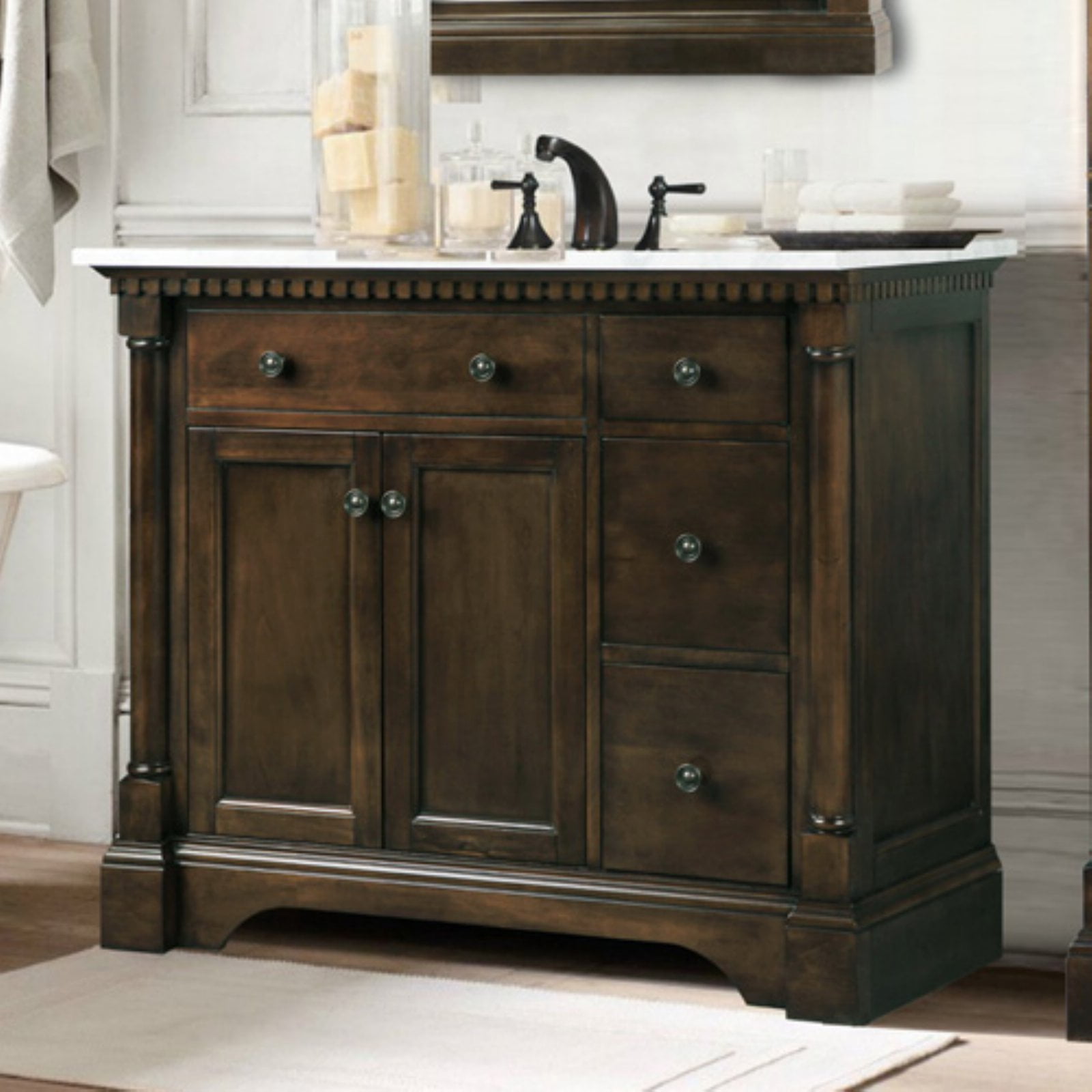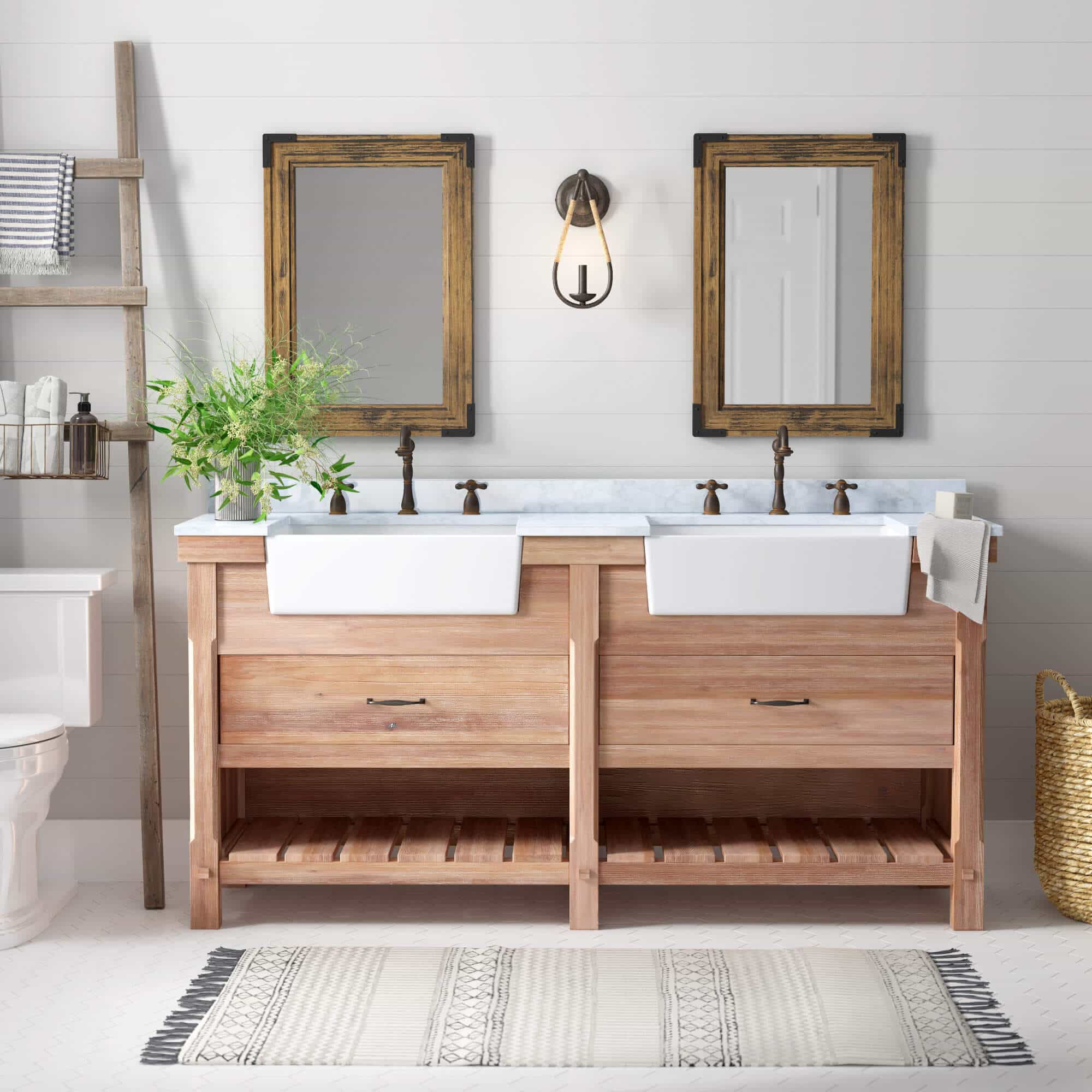The Allure of Antique Reproduction Bathroom Vanities

Antique reproduction bathroom vanities are a beautiful way to add a touch of timeless elegance to your home. These vanities capture the charm and sophistication of bygone eras, blending historical significance with modern functionality. Their unique designs and intricate details create a captivating focal point in any bathroom, transforming it into a sanctuary of style and comfort.
Popular Antique Bathroom Vanity Styles
Antique reproduction bathroom vanities draw inspiration from various historical periods, each offering a distinct aesthetic appeal. Here are some of the most popular styles:
- Victorian (1837-1901): Characterized by ornate carvings, intricate details, and a preference for dark woods like mahogany and walnut. Victorian vanities often feature elaborate pedestal bases, claw-foot legs, and decorative hardware.
- Edwardian (1901-1910): A transitional style that softened the opulence of Victorian design. Edwardian vanities often feature simpler lines, lighter woods like oak and maple, and delicate floral motifs.
- Arts & Crafts (1880-1920): Emphasized simplicity, functionality, and natural materials. Arts & Crafts vanities often feature handcrafted details, exposed wood construction, and a focus on natural textures and patterns.
Antique Bathroom Vanity Styles: Key Features and Historical Context
The following table showcases some of the key features and historical context of different antique bathroom vanity styles:
| Style | Key Features | Historical Context |
|---|---|---|
| Victorian | Ornate carvings, intricate details, dark woods like mahogany and walnut, elaborate pedestal bases, claw-foot legs, decorative hardware | Victorian era (1837-1901), characterized by opulence, industrialization, and a growing middle class. |
| Edwardian | Simpler lines, lighter woods like oak and maple, delicate floral motifs, often with a more streamlined and functional design | Edwardian era (1901-1910), a period of social and technological progress, with a shift towards a more refined and elegant aesthetic. |
| Arts & Crafts | Handcrafted details, exposed wood construction, natural textures and patterns, emphasis on functionality and simplicity | Arts & Crafts movement (1880-1920), a reaction against industrialization and mass production, promoting handcrafted objects and a connection to nature. |
Materials and Craftsmanship
The artistry of antique reproduction bathroom vanities lies not only in their aesthetic appeal but also in the meticulous selection of materials and the skilled craftsmanship that goes into their creation. These vanities are a testament to the enduring beauty of traditional techniques and the timeless appeal of classic designs.
Materials Used in Antique Reproduction Vanities
The choice of materials for antique reproduction vanities is crucial in achieving an authentic look and feel. These vanities are often crafted from high-quality hardwoods, such as oak, maple, cherry, walnut, and mahogany. These woods possess unique grain patterns, durability, and resistance to moisture, making them ideal for bathroom environments. The selection of wood is often influenced by the desired aesthetic and the specific era being replicated.
- Oak: Known for its strength, durability, and distinctive grain patterns, oak is a popular choice for antique reproduction vanities. Its rich color and ability to withstand moisture make it suitable for both traditional and modern styles.
- Maple: Maple is prized for its smooth, even grain and warm, honey-like color. It is often used in reproduction vanities that feature intricate carvings and delicate details.
- Cherry: Cherry wood has a beautiful reddish-brown hue that deepens with age. Its fine grain and natural resistance to moisture make it a suitable choice for antique reproduction vanities.
- Walnut: Walnut is known for its rich, dark brown color and distinctive grain patterns. Its durability and resistance to moisture make it a popular choice for furniture and vanities.
- Mahogany: Mahogany is a luxurious hardwood with a deep reddish-brown color and a beautiful, swirling grain. Its strength and resistance to moisture make it ideal for antique reproduction vanities.
Craftsmanship Techniques
The craftsmanship techniques employed in creating antique reproduction vanities are designed to replicate the methods used in the past. These techniques include:
- Mortise and Tenon Joinery: This traditional joinery method involves creating interlocking pieces that fit together precisely. Mortise and tenon joints are strong, durable, and aesthetically pleasing, adding to the authenticity of antique reproduction vanities.
- Dovetail Joints: Dovetail joints are a type of joinery used to connect two pieces of wood at a right angle. They are known for their strength and durability, and they are often used in antique reproduction vanities for drawer boxes and cabinet frames.
- Hand-Carving: Intricate carvings are often found on antique reproduction vanities, adding to their aesthetic appeal and authenticity. These carvings are typically done by hand, using traditional tools and techniques.
- Distressing: Distressing techniques are used to create the look of age and wear on antique reproduction vanities. These techniques may involve sanding, chipping, and staining to give the vanity a timeworn appearance.
Construction and Material Differences Between Authentic Antiques and Reproductions
While antique reproduction vanities strive to emulate the style and craftsmanship of authentic antiques, there are some key differences in construction and materials.
- Materials: Authentic antiques are often made from older, more mature wood that has been seasoned for years. Reproduction vanities may use newer wood, which may have different properties and characteristics.
- Construction: Authentic antiques were often constructed using traditional joinery techniques, such as mortise and tenon joints and dovetail joints. Reproduction vanities may use modern construction methods, such as glue and screws, to achieve a similar look.
- Finishes: Authentic antiques often have finishes that have aged and patinaed over time. Reproduction vanities may use techniques to create a similar look, but they may not have the same depth and character as an authentic antique.
- Hardware: Authentic antiques often feature original hardware, which may be made of brass, bronze, or iron. Reproduction vanities may use modern hardware that is designed to replicate the look of antique hardware.
Examples of Wood Finishes and Hardware Options
Antique reproduction vanities offer a wide range of wood finishes and hardware options to suit different styles and preferences.
- Wood Finishes:
- Natural Finish: A natural finish highlights the wood’s natural grain and color. It is often used for vanities made from high-quality hardwoods like oak, maple, or cherry.
- Stained Finish: Stained finishes enhance the wood’s color and create a richer, more dramatic look. Stains can be used to create a variety of colors, from light to dark.
- Painted Finish: Painted finishes can add a touch of elegance and sophistication to antique reproduction vanities. They are often used to create a classic, timeless look.
- Hardware Options:
- Brass Hardware: Brass hardware is a popular choice for antique reproduction vanities, as it has a warm, golden hue that complements a variety of wood finishes.
- Bronze Hardware: Bronze hardware has a rich, brown color that adds a touch of elegance to antique reproduction vanities. It is often used in traditional or rustic settings.
- Iron Hardware: Iron hardware has a classic, industrial look that is often used in contemporary or modern settings.
Incorporating Antique Reproduction Vanities into Modern Bathrooms: Antique Reproduction Bathroom Vanities

The allure of antique reproduction vanities lies in their timeless elegance and ability to add a touch of history to any bathroom. However, successfully integrating these pieces into contemporary spaces requires a thoughtful approach to design. This section will delve into the art of seamlessly blending antique reproduction vanities with modern bathroom aesthetics, exploring key design principles, color palettes, lighting choices, and decorative elements that enhance their appeal.
Design Principles for Seamless Integration
The key to seamlessly incorporating antique reproduction vanities into modern bathrooms is to strike a balance between the traditional and the contemporary. This involves selecting a vanity that complements the overall design style of the bathroom, while also considering the existing architectural features and the desired ambiance.
- Scale and Proportion: Choose a vanity that is appropriately sized for the bathroom space. Too large a vanity can overwhelm a small bathroom, while a small vanity may look lost in a spacious one.
- Style Compatibility: Consider the overall design style of the bathroom and choose a vanity that complements it. For example, a French country-style vanity might not be the best choice for a minimalist bathroom.
- Color and Material Harmony: Select a vanity in a color and material that complements the existing color scheme and materials in the bathroom. For example, a white vanity with brass hardware might be a good choice for a bathroom with a white tile floor and chrome fixtures.
Color Palettes and Lighting Choices
The color palette and lighting choices play a crucial role in creating a cohesive and stylish bathroom aesthetic. Antique reproduction vanities can be used as a starting point for selecting a color palette, with the chosen colors reflecting the vanity’s style and period.
- Color Palette: Opt for neutral colors like white, cream, or gray, as they provide a timeless backdrop for the vanity. To introduce a touch of warmth, incorporate muted tones of brown, green, or blue.
- Lighting: Lighting is essential for highlighting the vanity’s details and creating a welcoming ambiance. Consider using a combination of ambient, task, and accent lighting. Ambient lighting can be provided by recessed ceiling lights or sconces, while task lighting can be achieved with vanity lights positioned above the mirror. Accent lighting can be used to highlight specific features of the vanity, such as its carvings or hardware.
Decorative Elements for Enhancing Style
Decorative elements can be used to complement the antique reproduction vanity and enhance the overall style of the bathroom. These elements can include accessories, textiles, and artwork.
- Accessories: Incorporate accessories that complement the vanity’s style and period. For example, a vintage soap dispenser, a set of antique-style towels, or a decorative tray with antique-inspired details can add a touch of elegance and charm.
- Textiles: Choose textiles, such as rugs, curtains, or shower curtains, that complement the vanity’s color palette and style. For example, a bathroom with a traditional antique vanity might benefit from a patterned rug in muted tones of brown, green, or blue.
- Artwork: Incorporate artwork that complements the vanity’s style and the overall design of the bathroom. For example, a vintage botanical print or a landscape painting in muted tones could be a good choice for a bathroom with a traditional antique vanity.
Table of Bathroom Design Styles and Antique Vanity Choices, Antique reproduction bathroom vanities
The following table provides a guide to selecting antique reproduction vanities based on different bathroom design styles:
| Bathroom Design Style | Antique Vanity Choice |
|---|---|
| Traditional | A vanity with intricate carvings, ornate hardware, and a dark wood finish. |
| Contemporary | A vanity with a sleek, minimalist design, clean lines, and a light wood finish. |
| Transitional | A vanity that blends traditional and contemporary elements, such as a vanity with a simple design and modern hardware. |
| Rustic | A vanity with a distressed finish, reclaimed wood, and rustic hardware. |
| Industrial | A vanity with a metal frame, exposed pipes, and a distressed finish. |
